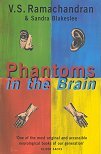Some people who have lost a limb still feel pain in it -- they have a phantom limb. What causes this? There have been many theories, but Ramachandran seems to have tracked down the cause -- the brain holds an active map of the body, and this map can go awry when its input is disturbed. The map is no longer getting input from the missing limb, so it confabulates input. The pain is literally "all in the mind", but no less real for that. This suggested some very simple experiments, which had the unexpected effect of curing the pain, even making the whole phantom limb vanish, in some cases.
Ramachandran talks about not just phantom limbs, but other strange effects the mind can play when its input is disturbed or destroyed in some misfortune. We have phantom visions, blindsight, neglect and paralysis denial, temporal lobe disorders, and a host of other weird effects. What makes this book more fascinating than a mere cataloging of strange brain problems, however, is Ramachandran's discussion of the causes of these problems, and the several brilliantly simple experiments and tests he had done to distinguish between various theories.
Like Oliver Sacks, Ramachandran obviously cares about his patients, and the simple tests he performs have gained deeper understanding to help them, and others like them. Beautifully written (although the footnotes sometimes seem to be commenting on a slightly different text), and deeply thought provoking.


